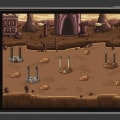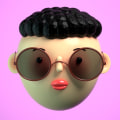Augmented and virtual reality have become increasingly popular in recent years, with more and more businesses and consumers embracing these technologies for their potential to enhance user experiences. As a result, the demand for AR/VR prototypes has grown exponentially, leading to the development of various tools for creating them. If you're looking to improve your UI/UX design skills in this exciting field, you've come to the right place. In this article, we will explore the latest trends in UI and UX design for augmented and virtual reality, and highlight the top tools available for creating AR/VR prototypes.
Whether you're a beginner or an experienced designer, this article will provide valuable insights and resources to take your AR/VR prototypes to the next level. So, let's dive in and discover how you can elevate your UI/UX design using the latest tools for creating AR/VR prototypes. In today's digital world, having a visually appealing and user-friendly website or mobile app is crucial for success. This is where user interface design comes in - it focuses on improving the usability and visual appeal of digital products. With the rise of augmented and virtual reality, designers now have access to powerful tools that can take their UI/UX design to the next level.
In this article, we will cover all about these tools and how they can help you create impressive AR/VR prototypes. First, let's define what AR/VR prototypes are and how they differ from traditional prototypes. AR (augmented reality) and VR (virtual reality) are both technologies that enhance the user's perception of reality by adding computer-generated elements. In the context of UI/UX design, AR/VR prototypes are digital mockups that allow designers to create and test their designs in a realistic virtual environment. The benefits of using AR/VR prototypes for UI/UX design are numerous. One major advantage is improved user engagement.
By creating immersive experiences, AR/VR prototypes can captivate users and keep them engaged with your product. This can lead to higher retention rates and increased customer satisfaction. Another benefit is the ability to gather more accurate feedback from users. With traditional prototypes, it can be difficult to fully understand how users will interact with the final product. However, with AR/VR prototypes, designers can observe how users navigate through the virtual environment and make adjustments accordingly.
This leads to more user-centered designs and ultimately a better user experience. So how can you create user-centered designs using AR/VR prototypes? One technique is to involve users in the design process. By allowing them to interact with the prototype, you can gather valuable insights and incorporate their feedback into your design. Additionally, it is important to consider responsive design for different devices when creating AR/VR prototypes. This ensures that your design will look and function seamlessly across various platforms. Now, let's explore some of the latest trends in UI/UX design with AR/VR.
One trend is the use of 3D elements in UI design. With AR/VR prototypes, designers have the ability to create and test 3D interfaces, which can enhance the user experience and make it more immersive. Another trend is the integration of haptic feedback, which adds a sense of touch to the virtual experience. This can further enhance user engagement and make the experience more realistic. To stay ahead of the game in UI/UX design with AR/VR, it is important to stay updated on the latest tools and techniques.
Luckily, there are many resources available for designers to learn and utilize these tools. Some valuable resources include online courses, tutorials, and design communities where you can collaborate with other designers and exchange ideas. In conclusion, AR/VR prototypes are powerful tools that can greatly improve the UI/UX design process. With their ability to create immersive experiences and gather accurate feedback, designers can create user-centered designs that will ultimately lead to a better user experience. By staying up-to-date on the latest trends and utilizing available resources, designers can take their UI/UX design to the next level with AR/VR prototypes.
So why wait? Start creating your own AR/VR prototypes today and see the impact it can have on your designs!
Responsive Design for Different Devices
In today's digital world, having a visually appealing and user-friendly website or mobile app is crucial for success. One important aspect of user interface design is responsive design, which ensures that your AR/VR prototypes are optimized for various devices. This means that your prototypes will look and function seamlessly on different screen sizes and resolutions, providing a consistent and enjoyable user experience. To achieve this, designers can use HTML structure with tags for main keywords and tags for paragraphs.This allows for flexible and adaptable designs that can adjust to different devices without compromising on visual appeal or usability.
Benefits of Using AR/VR Prototypes for UI/UX Design
In today's digital world, having a visually appealing and user-friendly website or mobile app is crucial for success. One of these tools is AR/VR prototypes, which offer numerous benefits for UI/UX design. Firstly, AR/VR prototypes allow designers to test their designs in a more realistic and immersive environment. This helps them to identify any potential issues or areas for improvement before the final product is released. By experiencing the design in a simulated AR/VR environment, designers can get a better understanding of how users will interact with their product. Secondly, AR/VR prototypes can help designers to visualize their ideas more effectively.With traditional 2D design tools, it can be difficult to fully convey the depth and scale of a design. However, with AR/VR prototypes, designers can create a 3D representation of their product, giving them a better idea of how it will look and feel in real life. Lastly, using AR/VR prototypes can save time and resources in the design process. By identifying and addressing any issues early on, designers can avoid costly revisions and ensure that the final product meets user needs and expectations.
Creating User-Centered Designs with AR/VR Tools
With the advancements in technology, augmented and virtual reality have become popular tools for creating immersive and engaging user experiences. These tools offer designers the ability to prototype and test their designs in a virtual environment, allowing for a more user-centered approach to design. One practical tip for using AR/VR prototypes in creating user-centered designs is to involve users in the design process.By allowing users to interact with the prototype, designers can gather valuable feedback and insights on the usability of the product. This allows for any necessary changes to be made early on in the design process, resulting in a more user-friendly end product. Another technique is to use AR/VR tools to create realistic and interactive user scenarios. This allows designers to test how users would interact with the product in different situations, leading to a more comprehensive understanding of the user's needs and preferences. Furthermore, AR/VR prototypes can also be used to conduct user testing and gather data on user behavior. This data can then be used to inform design decisions, ensuring that the final product meets the needs and expectations of its target audience. In conclusion, incorporating AR/VR tools into the design process can greatly enhance the creation of user-centered designs.
By involving users, creating realistic scenarios, and utilizing data from user testing, designers can ensure that their designs are optimized for usability and user satisfaction.
Understanding AR/VR Prototypes
Creating a successful user interface design involves a lot of trial and error, and it can be especially challenging when working with emerging technologies like augmented and virtual reality. In order to avoid costly mistakes and ensure a seamless user experience, designers often turn to prototypes. Prototypes are essentially mock-ups or early versions of a product that allow designers to test and refine their ideas before the final product is developed. With the rise of AR/VR, prototypes have taken on a whole new level of importance. So what exactly is an AR/VR prototype? Simply put, it is a prototype that uses augmented or virtual reality technology to showcase a product or design concept. Unlike traditional prototypes, which may be static or limited in their functionality, AR/VR prototypes allow for a more immersive and interactive experience. One of the key differences between AR/VR prototypes and traditional prototypes is the level of user engagement.Traditional prototypes may require users to click through screens or navigate menus, while AR/VR prototypes allow for more natural interactions through gestures and movements. Another important aspect of AR/VR prototypes is their ability to accurately simulate the final product. With traditional prototypes, designers may have to rely on their imagination or static mock-ups to envision the final design. With AR/VR prototypes, designers can actually experience the product in a realistic environment, providing valuable insights and opportunities for improvement. Overall, understanding the basics of AR/VR prototypes is crucial for designers looking to incorporate these technologies into their UI/UX design process. By utilizing these powerful tools, designers can create impressive and user-friendly AR/VR prototypes that will help elevate their digital products to the next level.
Valuable Resources for Creating AR/VR Prototypes
As augmented and virtual reality continue to gain popularity, the demand for high-quality AR/VR prototypes has also increased.Luckily, there are many tools and resources available to help designers create impressive prototypes that showcase the full potential of AR/VR technology.
1.Unity
Unity is a popular game development platform that can also be used for creating AR/VR experiences. Its intuitive interface and powerful features make it a go-to tool for many designers. With Unity, you can easily import 3D models, add animations and interactions, and test your prototype in real-time.2.Unreal Engine
Similar to Unity, Unreal Engine is a game engine that has been widely used for creating AR/VR content. It offers advanced features such as real-time rendering and physics simulation, making it a great choice for creating realistic and immersive prototypes.3.Sketch
Sketch is a popular design tool that has gained a lot of traction in the UI/UX community.While not specifically made for AR/VR design, it offers powerful features such as symbols and artboards that can be useful for creating interactive prototypes.
4.Figma
Figma is a web-based design tool that allows for collaborative work on projects. Its intuitive interface and real-time collaboration feature make it a great choice for teams working on AR/VR prototypes. With Figma, you can easily create and test interactive prototypes without the need for coding.5.VR/AR Association
The VR/AR Association is an organization that connects professionals in the VR/AR industry and provides resources for those interested in learning more about the technology. They offer workshops, events, and online resources that can be helpful for designers looking to improve their AR/VR prototype skills. With these valuable resources at your disposal, you can take your AR/VR prototypes to the next level and create impressive experiences for your users.Whether you are a beginner or an experienced designer, these tools and resources can help you bring your ideas to life and stay on top of the latest trends in UI/UX design.
Latest Trends in UI/UX Design with AR/VR
In today's digital world, user interface design is crucial for the success of any website or mobile app. It focuses on enhancing the usability and visual appeal of digital products. With the emergence of augmented and virtual reality, designers now have access to powerful tools that can elevate their UI/UX design to new heights. Augmented and virtual reality are changing the way users interact with digital products, and it's essential for designers to stay updated with the latest trends in this field. By incorporating AR/VR technology into their design process, they can create immersive and engaging experiences for users. AR/VR technology allows designers to think outside the box and push the boundaries of traditional UI/UX design.It offers endless possibilities for creating unique and interactive prototypes that can enhance the overall user experience. One of the biggest trends in UI/UX design with AR/VR is the use of 3D elements. With AR/VR, designers can add depth and dimension to their designs, making them more realistic and engaging for users. This trend is particularly popular in gaming and e-commerce industries, where product visualization is crucial. Another trend is the use of motion graphics and animations in AR/VR prototypes. These elements can bring designs to life and create a more dynamic and interactive experience for users.
They are especially useful in storytelling and marketing applications. Additionally, AR/VR technology allows for more personalized and customizable experiences for users. Designers can create prototypes that adapt to individual users' needs and preferences, making them feel more connected to the product. In conclusion, staying up-to-date with the latest trends in UI/UX design with AR/VR technology is essential for designers looking to elevate their skills and create impressive prototypes. By incorporating AR/VR into their design process, they can deliver immersive and engaging experiences that will set their products apart from the competition. AR/VR prototypes have revolutionized the UI/UX design process, providing designers with powerful tools to create more engaging and user-friendly digital products. By understanding the basics of AR/VR prototypes and implementing them in your design process, you can elevate your designs and stay ahead of the competition.
Keep up with the latest trends and utilize the valuable resources we have shared to take your UI/UX design to the next level.


